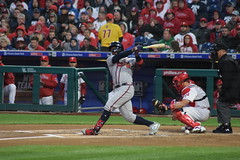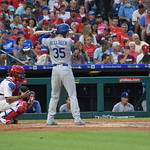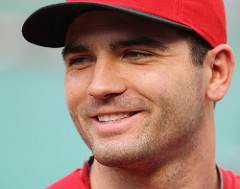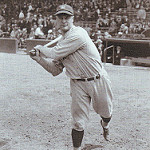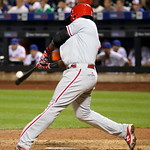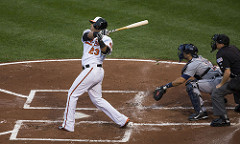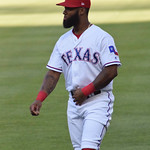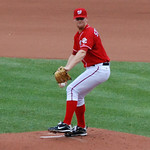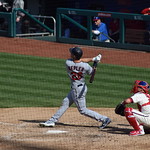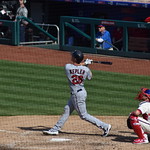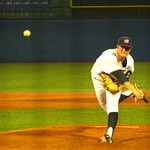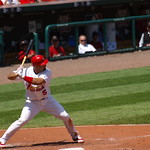 Yesterday, August 25, marked the 67th anniversary of Tigers’ righty Virgil Trucks’ admission to a pretty exclusive MLB “Club.” In fact, at the time Trucks made his mark, this Club had only two previous members – The Reds’ Johnny Vander Meer and the Yankees’ Allie Reynolds. In the 67 years since that time, this trio has been joined by three additional hurlers – Nolan Ryan, Roy Halladay and Max Scherzer. Trucks, however, remains its most unlikely member.
Yesterday, August 25, marked the 67th anniversary of Tigers’ righty Virgil Trucks’ admission to a pretty exclusive MLB “Club.” In fact, at the time Trucks made his mark, this Club had only two previous members – The Reds’ Johnny Vander Meer and the Yankees’ Allie Reynolds. In the 67 years since that time, this trio has been joined by three additional hurlers – Nolan Ryan, Roy Halladay and Max Scherzer. Trucks, however, remains its most unlikely member.
I am talking (writing) about MLB pitchers who have thrown two no hitters in a single season (or single season and post season in the case of Halladay. Let’s take a look at the membership of this club, starting with Trucks.
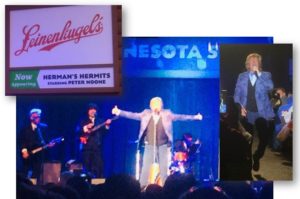 Note: Yep, I’m a day late on this celebration. You can blame the Minnesota State Fair and Peter Noone of Herman’s Hermits fame. I started this post yesterday morning, but had to head out to the Minnesota State Fair – for a day of great food (everything from foot-long hot dogs to T-bone lamb chops) and great things to look at (from demonstrations of mops to Belgian horses to lots of live music to pure people watching). It was all topped off by a 90-minute concert by Herman’s Hermits (one of my reasons for choosing yesterday). So, I may be a day late, but it was worth it.
Note: Yep, I’m a day late on this celebration. You can blame the Minnesota State Fair and Peter Noone of Herman’s Hermits fame. I started this post yesterday morning, but had to head out to the Minnesota State Fair – for a day of great food (everything from foot-long hot dogs to T-bone lamb chops) and great things to look at (from demonstrations of mops to Belgian horses to lots of live music to pure people watching). It was all topped off by a 90-minute concert by Herman’s Hermits (one of my reasons for choosing yesterday). So, I may be a day late, but it was worth it.
Now, those hurlers with two no-hitters in a single season.
Virgil Trucks (RHP), Tigers – No hitters on May 15 and August 25, 1952.
Distinction: Least likely member of the Two No-Hitters in One Season Club, won only five games that season.
In 1952, 35-year-old Virgil Trucks was toiling for the Detroit Tigers, who were on their way to a 50-104, last-place finish. On May 15, he took the mound against the Washington Senators. His record was 1-2, with an 8.47 earned run average. In his first four starts, he had lasted more than four innings just once.
That day, Trucks tossed a true gem, winning a 1-0, no-hit, complete-game shutout over Bob Porterfield and the Senators (in Detroit). Trucks walked one and hit two batters in completing his first no-no of his season (and career).
On August 25, Trucks faced an even tougher foe, the powerful Yankees (with the likes of Mickey Mantle, Hank Bauer, Yogi Berra and Phil Rizzuto in the lineup). At the time, the Yankees were 72-53 and the Tigers 42-8). Trucks, to that point in the season, had won four games and lost fifteen, although he had lowered his ERA to a respectable 3.55.
On this day, in a game played at Yankee Stadium, Trucks pitched his second complete-game, no-hitter of the season. And, once again, he needed it. Like his first 1952 no-no, Trucks emerged a 1-0 winner. The only Yankee base runners were RF Hank Bauer (who reached in the first inning on a catcher’s error after Trucks struck him out) and Mickey Mantle (who walked in the third inning). Trucks fanned eight in the game including Mantle and Bauer twice each.
For the season, Trucks finished with just five wins (against 19 losses) and a 3.97 ERA. Three of his fine victories were shutouts. (In ten of Trucks’ losses, the Tigers scored two or fewer runs.) Trucks enjoyed a 17-season MLB career (1941-58, missing 1944 due to military service). He went 177-135, 3.39 and was an All Star in 1949 and 1954 (at ages 32 and 37). He won 19 games (11 losses) for the Tigers in 1949 and for the White Sox (12 losses) in 1954. In 1949, he led the AL in strikeouts with 153 in 275 innings. Trucks was also a 20-game winner in 1953 (Browns/White Sox), when he went 20-10, 2.79. He threw 33 shutouts in his career, leading the AL twice (1949 and 1954).
Johnny Vander Meer (LHP), Reds … No-hitters on June 11 and June 15, 1938.
Distinction(s): First player to throw two no-hitters in a season; only player to throw two consecutive no-hitters.
Although Johnny Vander Meer is best known for throwing consecutive no-hitters, he should also be recognized for leading the National League in strikeouts for three consecutive seasons (1941-43). He was an All Star in 1942 and 43, before losing two prime seasons to military service.
On June 11, 1938 Vander Meer faced the Boston Bees in Cincinnati. At the time, the Bees were 21-20, the Reds 24-20. Vander Meer, at 23-years-old, was in just his second major league campaign – and he was off to a good start. He went into the contest with a 5-2 record, and a 2.77 earned run average. In his previous three starts he had pitched compete-game victories (one of ten innings) and had surrendered just 13 hits, three walks and three runs in 29 innings. Against the Bees that day, Vander Meer was even better.
He pitched a no-hitter as the Reds topped the Bees 3-0; walking three and fanning four – running his record to 6-2, 2,47.
Just four days later, Vander Meer took the mound against the Dodgers in Brooklyn. He came away with his seventh win – and a second consecutive no-hitter – as the Reds prevailed 6-0. It wasn’t exactly a flawless performance, as Vander Meer walked eight (and fanned seven). The June 15 no-no had one of the more tense finishes of any no-hitter. In the ninth inning, Vander Meer walked the bases loaded with one out, but got the next two hitters on a grounder to third (force at home) and a lazy fly to center.
In a six start stretch – from May 27 to June 19, 1938 – Johnny Vander Meet went 6-0, threw six complete games (two no-hitters), pitched 55 innings – giving up just 17 hits and four runs (0.65 ERA).
Vander Meer finished the 1938 season with a 15-10, 3.12 record and sixteen complete games in 29 starts. In his 13 MLB seasons, he went 119-121, 3.44. He won 15 or more games in four seasons. Notably, he was 75-66. 3.11 before losing two seasons (WW II) and 44-55, 3.93 after returning from military service.
Allie Reynolds (RHP), Yankees … No-hitters on July 12 and September 28, 1951.
Distinction: First American Leaguer with two no-hitters in a season.
The Yankees Allie Reynolds entered the 1951 season coming off two consecutive All Star campaigns – 17-6, 4.00 in 1949 and 16-12, 3.74 in 1950. When he started against the Indians on July 12, he was 9-5, 3.60 on the season and had made 13 starts (nine complete games) and eight relief appearances. He had been in a bit of a slump. In his previous three appearances (two starts), he had given up 13 earned runs in 10 1/3 innings pitched. He righted the ship in Cleveland on June 12, beating the Indians and Bob Feller 1-0, with a no-hitter (walking three and fanning four). From that point on in 1951, he went 13-6, 2.51 – and, of course, added a second no-hitter.
In his last 1951 regular-season start, Reynolds faced the Red Sox and 18-game winner Mel Parnell in New York. Reynolds pitched his second no-hitter of the season in an easy 8-0 Yankee win – walking four and whiffing nine. He ended the season 17-8, 3.05.
Allie Reynolds made the AL All Star five times between 1949 and 1954. The only year he missed was 1951, when he threw his two no-hitters and went 17-8. That year, he finished third in the MVP voting. Reynolds won 182 games (107 losses) in 13 MLB seasons (1942-54). He won 16 or more in seven campaigns, with a high of 20 wins in 1952 (20-8, with an AL-best 2.06 ERA). He led the AL in shutouts in 1951 (7) and 1952 (6). He also topped the AL in strikeouts in 1943 and 1952.
Nolan Ryan (RHP), Angels … May 15 and July 15, 1973.
Distinction(s): Ryan’s two 1973 no-hitters were the first two of his record seven career no-hitters; his second no-hitter that season included a record 17 strikeouts (in a no-hitter, since tied).
No surprise to find Nolan Ryan, twirler of seven career no-hitters, in this club.
Ryan’s first 1973 no-hitter came on May 15 against the Royals in Kansas City. He was 4-3, 3.09 at the time and had lost his last two starts. On this day, he would be superb, walking three and fanning a dozen, as he topped the Royals 3-0.
Two months later, July 15, Ryan would face the Tigers in Detroit. He was not exactly on fire at the time – sporting a 10-11 record. Still he had pitched well enough to have a better won-lost mark, boasting a 3.05 ERA and 203 strikeouts in 180 innings. In this contest, won by the Angels 6-0, Ryan would walk four and fan 17; notching at least one whiff against each member of the Tigers’ batting order. After evening his record at 11-11, Ryan would take off, finishing the season at 21-16, 2.87, completing 26 of 39 starts.
Ryan would finish his 27-seasons career at 324-292, 3.19, with an MLB record 5,714 strikeouts (and a record 2,795 walks) in 5,386 innings. He would be an eight-time All Star and a two-time 20-game winner, while leading his league in strikeouts 11 times (six times fanning more than 300 batters in a season), shutouts three times, ERA twice and innings pitched once. Two notable facts: 1) Ryan would go on to throw five more no-hitters, the last at age 44 (making him the oldest to throw an MLB no-hit game); 2) Ryan never won a Cy Young Award.
Something Extra for Minnesota Readers
On this date (August 26) in 1962, southpaw Jittery Jack Kralick (nicknamed for his fidgeting presence on the mound) tossed the first-ever Minnesota Twins no-hitter. (The franchise had two no-hitters before moving to Minnesota from Washington D.C. in 1961.) It came in a 1-0 in over the Athletics (Kansas City) in Bloomington and was very nearly a perfect game. Kralick retired the first 25 hitters he faced. Then, with one out in the ninth, he walked pinch hitter Billy Bryan (hitting .226 at the time), before getting the final two outs. Kralick fanned three in the game. Kralick finished the season 12-11, 3.86.
Kralick pitched nine seasons in the majors (Senators/Twins and Indians), going 67-65, 3.56. His highest win total was 14 (against 13 losses) in 1963. He was an All Star once (1964, Indians) and posted ten or more wins four times.
Roy Halladay, (RHP), Phillies … May 29 and October 6, 2010.
Distinctions: Halladay’s first 2019 no-no was a perfect game; his second was just the second post-season no-hitter ever (the first being Don Larsen’s 1956 World Series perfect game. (Does that require an asterisk beside his line on this list?)
The 33-year-old Roy Halladay was in his 13th MLB season when he tossed his two no-hitters. The first came on May 29 – on the road against the Marlins. Halladay needed the effort, as his Phillies squeaked by 1-0. Halladay’s outing produced a perfect game, with 11 strikeouts. It was his seventh win of the season (versus three losses) and lowered his earned run average to 1.99. Halladay had lost his previous two starts – a nine-inning complete game in which he gave up just two runs and a 5 2/3 inning outing in which he surrendered seven runs (six earned).
Halladay finished the regular season with a 21-10, 2.44 record – leading the NL in wins, complete games (9), shutouts (4), innings pitched (250 2/3) and earning a Cy Young Award.
Halladay’s second no-hitter of 2010 may not have been a perfect game, but it came at a perfect time – in Game 1 of the National League Division Series. Halladay shut down the Reds (in Philadelphia) 4-0, on no hits, one walk and eight strikeouts. He also went 1-for-3 in the game with a run scored and an RBI.
In his 16-season MLB career, Halladay won 203 games (105 losses) and put up a 3.38 ERA. He was a three-time 20-game winner (leading his league in victories twice) and led his league in complete games seven times, shutouts four times and innings pitched four times. He won a Cy Young Award with the Blue Jays in 2003 and the Phillies in 2010.
Max Scherzer (RHP), Nationals … June 20 and October 3, 2015.
Distinction: In his second no-hitter, Scherzer tied the MLB record for strikeouts in a no-hitter with 17.
Max Scherzer threw his two no-hitters in his eighth MLB season – at age 30 – in his first season with the Nationals. (He led the AL in wins in 2014 before becoming a free agent and signing with the Nats.)
The first of his no-no’s came on June 20 and he might have signaled the gem in his previous start (June 14), when he tossed a one-hit, one-walk, sixteen-strikeout, complete-game shutout against the Brewers. He came back on June 20th to no-hit the Pirates 6-1 in Washington, surrendering no walks and fanning ten. His outing was so-o-o close to a perfect game. He hit pinch hitter Jose Tabata with a pitch with two outs in the ninth for the only Pirates’ base runner. The win left him with an 8-5, 1.76 record on the season.
On October 3, Scherzer was arguably even better than on June 20. In his second no hitter, he beat the Mets 2-0 in New York. In that game he walked none and fanned 17 (tying the record for whiffs in a no-hitter). The only base runner (Kevin Plawecki) came on a sixth-inning error by Nationals’ 3B Yunel Escobar.
Surprisingly, 2015, the year of his two no-hitters, saw Scherzer win the fewest games (14) in any season between 2011 and 2018. He was 14-12, 2.79 – but still led the NL in complete games (4) and shutouts (3), Now in his 12th season, Scherzer has been an All Star the last seven campaigns, has won three Cy Young Awards, led his league in wins four times, starts twice, complete games three times, shutouts twice and strikeouts three times. His record to date is 168-87, 3.17 with 2,641 strikeouts in 2,256 innings pitched. His best season was 2018, when he went 21-3, 2.90 for the Tigers.
Primary Resource: Baseball-Reference.com
BASEBALL ROUNDTABLE ON THE TOP 100 BASEBALL BLOG LIST
 Baseball Roundtable is on the Feedspot list of the Top 100 Baseball Blogs. To see the full list, click here.
Baseball Roundtable is on the Feedspot list of the Top 100 Baseball Blogs. To see the full list, click here.
I tweet baseball @DavidBBRT
Follow/Like Baseball Roundtable’s Facebook Page here. More baseball commentary; blog post notifications; PRIZES.
Member: Society for American Baseball Research (SABR), The Baseball Reliquary, the Negro Leagues Baseball Museum.














































